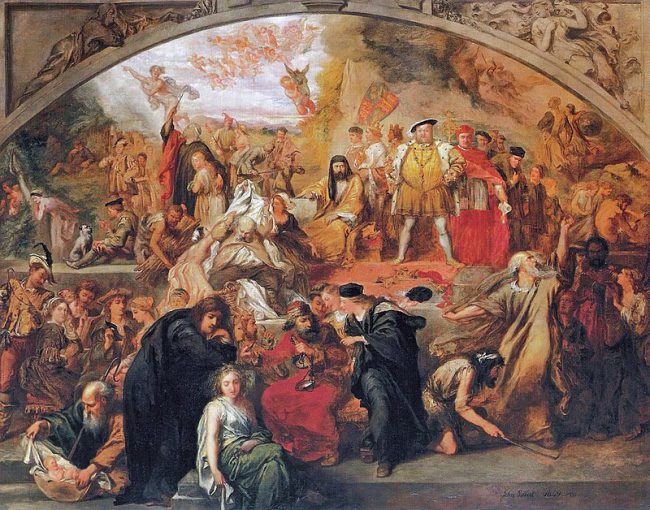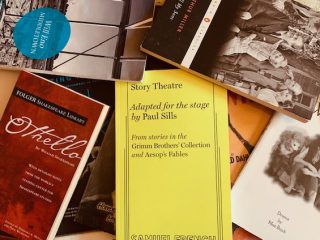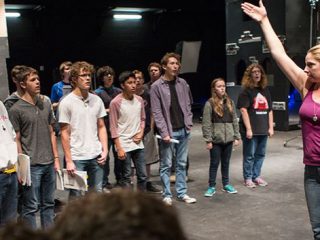Welcome to the first blog post in our new series: Analyzing the Drama. In these posts, we will explore how to read different genres in order to improve our understanding of the plays. First up, we take a look at English Renaissance tragedies.
Anatomy of a Renaissance Tragedy
When it comes to dramatic analysis, the essential model is Aristotle’s Poetics, the Ancient Greek treatise that lays out how we should understand poetry–including plays. Aristotle breaks down plays (specifically tragedies) into six components that work together to tell the story: Plot, Character, Thought, Diction, Song, and Spectacle. For thousands of years in Western theatre, playwrights have used this formula to create compelling and engaging dramas.
For Aristotle, a tragedy should be serious, complete, and great in magnitude. However, each era and culture has put their own twist on how tragedy should be presented on the stage. In this post, we’ll focus on English Renaissance tragedies and apply this type of analysis to Shakespeare’s Othello.

Plot: The Arrangement of Conflict
When it comes to plot, consider two elements: conflict and structure. The conflict refers to the struggle of the protagonist. In Renaissance tragedy, determining the central conflict can be tricky because there are often so many subplots happening. For example, in Othello, several conflicts appear. Othello and Desdemona marry in secret against her father’s wishes. There is the threat of a Turkish invasion in Cyprus. Iago is furious that he was passed over for a promotion and vows revenge against Othello. In Act One alone, there is already a lot going on.
English Renaissance tragedies are full of affairs of state, such as war, alliances, and espionage. Often, the central and most significant conflicts in tragedy are not only battles against an opposing force (an external conflict), but also the hero’s internal struggles with his relationships, insecurities, and obstacles. While Othello is a brave and able commander, he trusts the wrong people–notably Iago, who is able to deftly manipulate Othello’s emotions. Within Othello, the central conflict is Othello’s jealousy; he has succumbed to the “green-eyed monster.”
To properly analyze the conflict and how it develops throughout the play, we must examine the structure of the play. Renaissance playwrights utilized the five-act structure, a blueprint for how the conflict should unfold.
- Act One: This is the exposition and important background information of the central characters. We are introduced to the circumstances of the world of the play and, by the end of the act, we learn what the central conflict is. In Othello, we learn about the secret marriage, the impending war, and Iago’s snub. Because he was passed over for a promotion, Iago declares he will get revenge.
- Act Two: The conflict gets complicated, also known as the rising action. Iago begins to sow doubt about Desdemona’s faithfulness (he implies that she is flirting with Cassio), and he tricks Cassio into drinking and fighting, which results in Othello demoting the lieutenant.
- Act Three: The crisis and turning point. Something happens that changes the stakes of the conflict. In Othello, the turning point is the handkerchief. When Othello sees Cassio give his handkerchief to Bianca, he is sure that Desdemona has been unfaithful, and demands that Cassio be killed.
- Act Four: Following the turning point, the plot continues to complicate the conflict. In this act of Othello, other people are now witnesses to Othello’s jealousy–at one point, he hits Desdemona and shocks those around him who thought that he was so level-headed. Iago’s plan is working: Othello’s moral character is crumbling, and the public is witness to it.
- Act Five: Every conflict must end, and the final act of the play is the climax and denouement. Famously, Othello stalks into Desdemona’s bedchamber: “Put out the light, then put out the light.” Importantly, the climax of the play also includes the hero’s epiphany–he recognizes his mistakes, but can never go back and correct his actions. After he kills her, Othello learns that Iago manipulated him and Desdemona was innocent. He dies, Iago states that he will “never speak word” about his motives, and Lodovico draws the curtains so that the bodies will not be seen.
This structure is applicable to all five-act plays in the Renaissance (even comedies).

Characters: Noble and Flawed
Aristotle’s descriptions of tragic heroes (the protagonists) demanded noble characters burdened with weighty purpose. In the Renaissance, that characteristic is still very applicable. The hero is someone of an aristocratic or royal station. He is well-spoken, intelligent, and admired. He is often a leader and inspires others around him. But he is also human and therefore flawed. When the central conflict appears, the tragic hero steps up to face the challenge–but often the only way to defeat that challenge is through sacrifice and death.
It’s important to remember that just because a character is a protagonist–what we today would call the “hero”–it doesn’t mean that they are inherently good. Many of the best tragic heroes in Renaissance plays are conflicted and complicated and try our patience: Hamlet and his inaction, Lear and his neediness, Macbeth and his hubris. These characters are never in isolation; while they may be dealing with heavy affairs of state, they are also negotiating family relationships and friendships. The antagonist–the person who is the most profound obstacle–is often closely connected to the hero, which is why there always seems to be a sense of betrayal in the conflict.
In Othello, the tragic hero is Othello himself. While he was not born noble, he worked his way into a position of respected leadership. As he did so, Othello built friendships and relationships: Iago, Cassio, Desdemona, Brabantio, Ludovico. However, his weakness is in how much he trusts the wrong people and it is very easy for Iago (the antagonist) to foster his jealousy and doubt.
Thought, Diction, and Song: The Language of the Play
While all six of Aristotle’s elements of tragedy are connected, thought, diction, and song are the most intertwined. The thought of the play, according to Aristotle, is the effect of the play. Today, we characterize that effect as the theme. Essentially, what is the message from the playwright? We learn that theme through diction, the choice of words used by the characters. How these characters speak can tell us so much about who they are, what they value, how they view their world, others, and themselves. This presentation of language, the rhythm and patterns of speech, is song.
During Renaissance England, playwrights wrote dialogue in verse or prose, and sometimes used both patterns in the same scenes. Prose is any language that is not written as poetry–in many ways, it echoes common, natural speech. Generally, the characters in Renaissance plays who speak in prose are lower-class and less-educated. If an upper-class character speaks in prose, it is usually a signal that they have fallen in some way–morally, financially, socially, etc.
More frequently, playwrights used verse for their characters. It is a more sophisticated method of language that relies on carefully constructed rhythmic patterns. Shakespeare and many of his contemporaries relied on iambic pentameter in their plays. This pattern of unstressed-stressed syllables most closely mimics the heartbeat and breathing, which is appealing to the actor performing such dense passages. This pattern allows the playwright to also manipulate language in order to emphasize particular words (the diction), which helps us determine the thought of the piece.
In the final scene of Othello, the Moor enters Desdemona’s bedchamber, determined to kill her: “It is the cause, it is the cause, my soul.” By scanning this line, we see that the words is, cause, and soul are stressed. That gives us further insight into Othello’s mindset and his anguish over what he is about to do: He believes he must take action to assert justice for himself. Throughout the play, Iago has manipulated Othello into overwhelming and all-consuming jealousy. For the tragic hero, he must take action against those he believes have wronged him.
Spectacle: Sights, Sounds, and Descriptions
Aristotle acknowledged the importance of spectacle, but made it clear that he believed a play should never rely on it. Spectacle is the sensory experience of the play: the sights, sounds, and even smells that accompany the performance. In the Ancient Greek plays, spectacle was usually confined to horrific descriptions of death, presented by messengers. Perhaps the doors to the palace would open to reveal a bloody sight. Occasionally, a deus ex machina would appear–literally, “god from a machine.” In this case, the god would be brought in with stage machinery to dispense justice over the mortal characters below.
However, English Renaissance playwrights loved spectacle. It is in the sword fights and battle cries, the murders and crowds. The stages of the playhouses had balconies above and trapdoors below. Even though the sets were simple, the playwrights incorporated vibrant props, sound effects, and visual effects. In Othello, Shakespeare gives us eloquent descriptions of the storms in Act Two and the brawl in Act Three. When Othello prepares to kill Desdemona, he determines that he will not shed her blood–a stark contrast to the other gruesome deaths of the play. The spectacle is not in the splattering blood from a stabbing, but instead in the unrelenting and violent struggle as Othello smothers Desdemona. We learn more about his character and his determination to avenge his own honor as he kills her slowly and cruelly.
A Final Word on Dramatic Analysis
Tragedies of the English Renaissance followed a formula, and they were very successful and popular. Once we understand how the plays are put together, we can analyze the intricacies of Aristotle’s elements and get to grips with them much more easily.
For more tips on tackling Renaissance drama, check out these blog posts:














